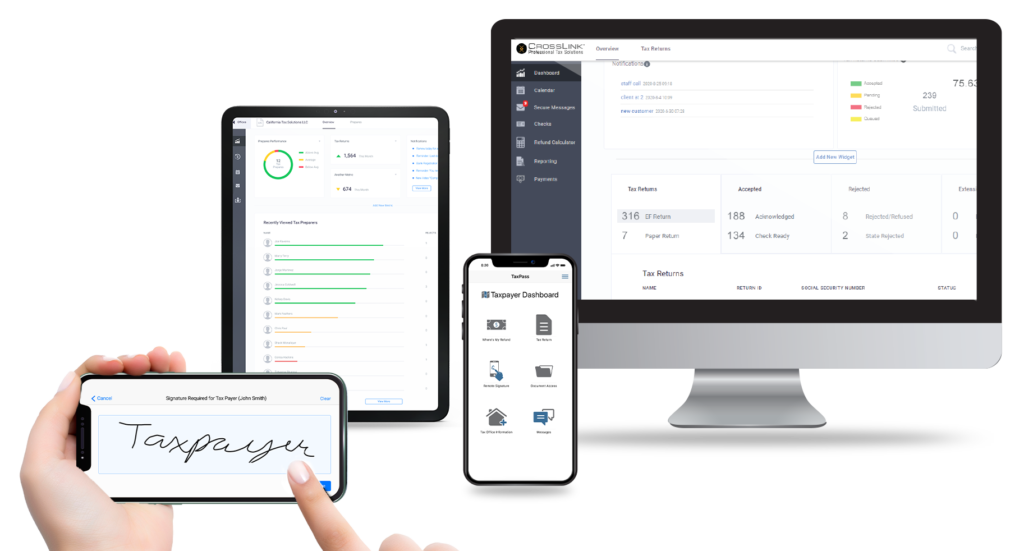How Do Taxes Work?
The U.S. tax system is extremely complex, leading many often ask the question, “How do taxes work?” This article is meant to help you understand what taxes are, how taxes work, the different tax forms that exist, and how to file your taxes.

What are Taxes?
Income taxes are a type of tax that the federal and most state governments impose on an individual’s or business’ income. All individuals and businesses must file an income tax return annually.
The U.S. tax system imposes a progressive tax in which the tax rates increase with income. It is also a voluntary system in the sense that taxpayers report all of their earnings by filing an annual income tax return and compute their tax themselves. However, paying and filing their income tax is required by law.
For individuals, there is a personal income tax that is imposed on their wages, salaries, and other types of income.
Business’ such as corporations, S corporations, partnerships, and self-employed individuals are taxed on their taxable business income. For S corporations and partnerships, the net business income is passed thru to the shareholders and partners who then report it on their personal income tax return. Self-employed individuals report their business income and expenses on their personal income tax on Schedule C.
Direct Taxes
Direct tax is a tax paid directly to the government agency or authority that is imposing the tax.
Examples of a direct tax are:
- Individual and Corporate income tax
- Capital Gains Tax
- Estate Tax
- Property taxes
Indirect Taxes
Indirect taxes are imposed only when a taxable transaction occurs. Examples of indirect taxes are sales tax, excise taxes, consumption taxes, or value added taxes.
An indirect tax is collected by an intermediary when the taxable transaction takes place, such as purchasing an item at a retail store. The retail store will then forward the tax on to the applicable government agency when they file a return during the year.
Income Types
For tax purposes, the types of taxable income for individuals are:
- Employee compensation – Includes salaries/wages, commissions, tips, fringe benefits, and stock options
- Rental Income – Income received from renting real estate
- Net Business Income – from a sole proprietorship
- Investment Income – Includes interest, dividends, royalties, and capital gains and losses
- Unearned Income – Income not received through work or business activities
- Earned Income – Income received from employment, work, or through business activities
- Passive Income – Earnings that are received from rental property, a limited partnership, or other business activity in which the individual is not actively involved
- Pass-thru Income from Partnerships and S Corporations – reported to individual on a K-1
Employment Taxes
Employment taxes (usually referred to as payroll taxes) are taxes that employees and employers pay based on the wages and salaries paid by employers and tips earned by the employee. The employee pays their portion of these taxes through a deduction from their wages, and the employer pays their portion directly to the IRS when they file their payroll tax returns during the year.
Examples of payroll taxes are:
- The Federal income tax that each employee must have withheld from their wages
- Social Security and Medicare taxes, which the employee pays half and the employer pays half
- Federal Unemployment Tax, which the employer pays each year
Capital Gain
A capital gain is the profit that an individual has from the sale of property or an investment.
For tax purposes, the sale of property or stock is reported on Schedule D and if the taxpayer realizes a gain on the sale, it is either short-term (property held less than one year) or long-term (property held for longer than one year). A short-term capital gain is taxed as ordinary income and a long-term gain is taxed at the capital gains rate of 0%, 15%, or 20% depending on the taxpayer’s taxable income.
Dividend
A dividend is a distribution of cash, stock, or other property to a publicly listed company to its eligible shareholders. These distributions are made out of a company’s profits as a reward to investors for purchasing stock in the company.
Dividends are taxable to the individual in the year they receive it.
Interest
Interest is the cost an entity, such as a bank, charges for loaning money to individuals and businesses. It also is the amount that an entity, such as a bank, will pay to individuals or businesses that deposit their money at the entity.
Interest income is the earnings generated from interest-yielding investments such as savings accounts, Certificate of Deposits (CDs), and other investments that pay some form of interest.
Interest income is taxable to the individual in the year they receive it.

How to File Taxes
For federal purposes, every individual who has total taxable income over a certain threshold (more than $12,550 or $25,100 if filing Married Filing Joint for 2021) must file a federal income tax return each year.
Tax Forms
To file a federal income tax return, individuals need to file, at a minimum, the following tax forms:
1040 (U.S. Individual Income Tax Return)
Form 1040 is the main form that an individual uses to file their annual federal income tax return. The individual enters their taxable income, claims deductions and credits, enters their tax withheld from their wages, and any other payments they have made during the year, and with this information determines whether they will receive a refund or owe additional tax.
Form 1040 generally must be filed by April 15 each year, however if an individual needs more time to gather their information, the IRS grants taxpayers an automatic six-month extension until October 15 to file their federal income tax return. If the individual believes they will owe additional tax, they must pay that tax by April 15 or they will owe penalty and interest for not paying their tax on time.
The Form 1040 includes the most common income deductions and credits. If the individual needs to report additional income items or claim additional deductions or credits, they may need to use the following:
- Schedule 1 (Additional Income and Adjustments)
This schedule is used to report all taxable income that is required on Form 1040 such as business income, rental income, alimony received, etc.
It is also used to report adjustments to income such as IRA deduction, educator deduction, self-employed health insurance deduction, student loan interest deduction, and other deductions that may be reported as adjustments to income on Form 1040.
- Schedule 2 (Additional Taxes)
This schedule is used to report taxes such as alternative minimum tax, self-employment tax, etc. that if applicable, is reported on Form 1040.
- Schedule 3 (Additional Credits and Payments)
This schedule is used to report non-refundable credits such as education credits, retirement savings account credit, adoption credit, etc. that, if applicable is reported on Form 1040.
Schedule 3 is also used to report refundable credits and other payments that, if applicable, are reported on Form 1040.
Individuals may also need other forms and schedules to report such items as business income or loss, capital gains or losses, rental income, etc.
See the following on the IRS website for more information completing the Form 1040:
- IRS Publication 17 (Your Federal Income Tax)
- Form 1040 instructions
- About Form 1040
Other Federal Individual Tax Forms an Individual May Need
Below are some of the forms and schedules an individual may need in addition to the Form 1040 and Schedules 1, 2 or 3:
Schedule A (Itemized Deductions)
This Schedule is used by taxpayers to claim itemized deductions. A taxpayer may claim an itemized deduction if their total itemized deductions exceed their standard deduction based on their filing status.
Itemized deductions that may be claimed are:
- Medical expenses if they exceed 7.5% of the taxpayer’s Adjusted Gross Income
- State and local taxes
- Mortgage interest paid during the year
- Charitable contributions
- Casualty and theft losses related to a federally declared disaster area
See the following on the IRS website for more information on what itemized deductions an individual may claim on their federal income tax return:
Schedule C (Profit of Loss from Business)
This Schedule is used by sole proprietors to report their income and expenses for the year.
A sole proprietorship is a business or profession that an individual engages in. An activity qualifies as a business if the primary purpose for engaging in the activity is for income or profit and the individual is involved in the activity with continuity and regularity.
See the following on the IRS website for more information on completing Schedule C and for information on the federal tax laws that apply to small businesses that are sole proprietorships:
- Schedule C instructions
- Publication 334 – Tax Guide for Small Businesses
Schedule D (Capital Gains and Losses) and Form 8949 (Sales and Other Dispositions of Capital Assets)
The Schedule D and Form 8949 are closely linked. An individual enters on Form 8949 the information on any sales and exchanges of capital assets. The total of all information entered on Form 8949 is then transferred to Schedule D to determine the total capital gains and losses that is then reported on Form 1040.
For sales or exchanges of stock or other investments that were made via a broker, the Form 8949 allows an individual and the IRS to reconcile the amounts that were reported to the individual and the IRS on Forms 1099-B. The 1099-B (Proceeds from Broker and Barter Exchange Transactions) is sent to individuals each year if the individual has sold stocks or bonds during the year.
Schedule D is used to figure an individual’s total short-term and long-term capital gains and losses. All information on Schedule D is a summary of information that is entered on other federal forms and schedules, such as:
- Overall gain or loss from transactions reported on Form 8949
- Gains from Form 2439, 6252 or Form 4797, Part I
- Gain or loss from Form 4684, 6781 or 8824
- Gain or loss from a partnership, S corporation, estate or trust
See the following on the IRS website for more information:
- Form 8949 instructions
- Schedule D instructions
- IRS Publication 544 (Sales and Other Disposition of Assets)
- Publication 550 (Investment Income and Expenses)
Schedule E (Supplemental Income and Loss)
Schedule E is used by individuals to report their income or loss from rental real estate, royalties, partnerships, S corporations, estates, and trusts.
An individual’s income and expenses for rental real estate is reported on page 1. An individual’s share of net income or loss from a partnership, S corporation, and/or estate/trust is reported on page 2.
The information that an individual must report on Schedule E, page 2 is reported to the individual on a K-1 that they receive from a partnership, S corporation, and/or an estate/trust.
For more information on how to complete Schedule E see the following on the IRS website:
Form 2441 (Child and Dependent Care Expenses)
This form is used by individuals to claim the credit for child and dependent care if they paid someone to care for their child or other qualifying person so they can work or look for work during the year.
Form 2441 must also be used by an individual who received dependent care benefits from their employer during the year. If they did receive these benefits, they must use Form 2441 to figure the amount, if any, of the benefits they can exclude from their income.
See the following on the IRS website for more information on how to complete Form 2441 and who is eligible to use it:
- Form 2441 instructions
- Child and Dependent Care FAQs
- IRS Publication 503 (Child and Dependent Care Expenses)
Form 8962 (Premium Tax Credit)
Form 8962 is used to figure the amount of an individual’s premium tax credit and reconcile it with any advance payment of the premium tax credit they received during the year to help pay for their health insurance purchased through the Marketplace.
An individual may claim the premium tax credit (PTC) only if they purchased their health insurance for the year through a Health Insurance Marketplace (either through Healthcare.gov or State Exchange).
All individuals who purchased their health insurance through the Marketplace receive a Form 1095-A (Health Insurance Marketplace Statement). Most individuals who purchased their insurance through the Marketplace qualified for and received a subsidy to help pay for their monthly health insurance premiums. If an individual received an advanced premium tax credit (subsidy), they must reconcile the total subsidy they received with the calculated credit on the Form 8962 to determine if they will receive an additional refundable credit or will need to pay some of the subsidy back (because the amount of subsidy received is more than the calculated credit).
See the following on the IRS website for more information on how to complete Form 8962, who may claim the premium tax credit, and who must complete the reconciliation portion of the form:
- Form 8962 instructions
- IRS Publication 974 (Premium Tax Credit)
- About Form 1095-A (Health Insurance Marketplace Statement)

Information Forms
Individuals may also receive the following information forms at beginning of each year:
Form 1095-A (Health Insurance Marketplace Statement)
This information form is used to report certain information to the IRS about individuals who enroll in a qualified health plan through the Health Insurance Marketplace.
Form 1095-A is also furnished to individuals to allow them to claim the premium tax credit. This is then used to reconcile the credit on their federal return with advance payments of the premium tax credit (subsidy) that they received during the year.
Individuals need the information from the Form 1095-A in order to complete the Form 8962 (Premium Tax Credit).
1099
A Form 1099 is an information form that reports certain types of non-employment income that an individual has earned or received during the year.
There are many types of Form 1099s that an individual may receive each year. Here are some of the most common an individual may receive:
- 1099-R (Distributions from Pensions, Annuities, Retirement, or Profit-Sharing Plans, IRAs, Insurance Contracts, Etc.)
Most commonly, the Form 1099-R is received by any individual who received a distribution during the year from a pension plan or an IRA.
The information from a Form 1099-R is entered on the individual’s federal income tax return on Form 1040, line 4 (IRA distributions) or line 5 (Pensions and annuities).
- 1099-INT (Interest Income)
A 1099-INT is sent to individuals who earned more than $10 in interest during the year from a bank, brokerage firms, etc.
- 1099-DIV (Dividends and Distributions)
A 1099-DIV is sent to individuals who earned dividend income during the year.
- 1099-MISC (Miscellaneous Information)
A 1099-MISC is sent to individuals to report other non-employment income that is not reported on other 1099 forms. Examples include rent, royalties, fishing boat proceeds, crop insurance proceeds, and prizes/awards.
- 1099-K (Payment Card and Third-Party Network Transactions)
A Form 1099-K is used to report certain payment transactions. An individual should receive a Form 1099-K if, during a calendar year, they received payments:
- From payment card transactions (debit cards, credit or stored-value cards), and/or
- In settlement of third-party payment network transactions above the minimum reporting thresholds as follows:
- For returns for calendar years prior to 2022:
- Gross payments that exceed $20,000, AND
- More than 200 such transactions
- For returns for calendar years after 2021:
- Gross payments that exceed $600, AND
- Any number of transactions
- For returns for calendar years prior to 2022:
See Understanding Your Form 1099-K on the IRS website for more information.
- 1099-G (Certain Government Payments)
A 1099-G is sent to individuals who received money from a government entity. The most common example is for unemployment benefits.
- 1099-NEC (Nonemployee Compensation)
A 1099-NEC is used by businesses to report any non-employee compensation to a non-employee (contractor) they paid $600 or more during the year to the IRS and the individual.
- 1099-B (Proceeds From Broker and Barter Exchange Transactions)
A 1099-B is sent to an individual by a broker listing any sales of stocks, commodities, or other securities that were owned by that individual during the year.
Information from the 1099-B is used to complete Form 8949 on the individual’s federal income tax return.
- Form 1099-S (Proceeds from Real Estate Transactions)
An individual will receive a 1099-S if they sold or exchanged real estate. For most individuals, this would be for the sale of their main home, vacation home, or rental house.
Taxpayers will receive a 1099-S from a mortgage lender, a real estate broker, or the person responsible for closing the real estate transaction.
Form 1098 (Mortgage Interest Statement)
A Form 1098 is sent to individuals who have a mortgage on their homes by the financial institution that made the loan on the house or now holds the loan on the house.
The Form 1098 tells the individual how much mortgage interest and points they paid during the year.
In most instances, an individual reports mortgage interest as an itemized deduction on Schedule A. In order to receive a deduction for mortgage interest on their return, the individual must have itemized deductions that are greater than the standard deduction for their filing status. If the mortgage interest is for a rental property, the mortgage interest would be reported on Schedule E for the applicable rental property it is for.
W (Tax Worksheet)
A tax worksheet is a detailed guide that helps the taxpayer determine how to calculate a line item on a federal or state income tax return.
Tax worksheets are included in the instructions for a particular form or schedule and they are not included when the income tax return is filed with the IRS or a State Department of Revenue. They should be kept along with the tax return in case there are any questions in the future as to how the line on the income tax return was calculated.
Tax Brackets
A tax bracket refers to a range of incomes subject to a certain income tax rate. There are presently seven federal tax brackets ranging from 10% to 37%. The dollar ranges for each bracket varies for each filing status.

Important Dates
Here are some of the important dates to know related to filing an individual federal income tax return:
- April 15 – Due date for filing Form 1040 or filing a Form 4868 (Extension) if the taxpayer believes they will owe additional tax and needs more time to file their federal income tax return.
- October 15 – Extended due date for filing Form 1040
- April 15, June 15, September 15 and January 15 – Due Dates for making individual estimated payments for each calendar year.
Tax Tips
Tax tips are tax information that a taxing authority is frequently asked about or wants individuals to be aware of to be sure that taxpayers complete their income tax return in an accurate manner and take advantage of all qualified deductions and credits.
The IRS provides the following Tax Tips for each filing season on their website.
Other IRS pages that provide similar information for tax preparers and taxpayers are:
- IRS Fact Sheets
- Credits and Deductions information page
- File page which provides filing information for individuals and businesses
- Credits and Deductions for Individuals page
- Tax Information for Individuals page
- Tax Information for Businesses page
Prepare Taxes
Each year, all individuals who have earned or received taxable income over a certain income threshold must file a federal income tax return and, in most States, a state income tax return.
In order to prepare their yearly income tax return, individuals need to do the following:
- Each January individuals will receive various tax documents. They will need to gather all of these documents which include W-2s, 1099s, etc.
- To determine if they can itemize or take certain deductions or credits, an individual will need to gather all their receipts, organize and total them.
- Individuals should review last year’s income tax returns to help them determine that they have all of the tax documents and receipts they may need to complete the current year income tax return.
Software
Tax software is computer software that is designed to assist individuals and businesses prepare their federal and state income tax returns.
Tax software is used by tax professionals to prepare their customers’ yearly tax returns. There are also do-it-yourself versions of tax software that are available either online or for purchase at retail stores that allow individuals to complete their returns themselves.
Tax software is a tool that, based on the information entered into it, will calculate the taxpayer’s taxable income and total tax to determine whether they will receive a refund or owe additional tax for the year.

CrossLink Professional Tax Software
CrossLink is the industry’s leading professional tax software solution for high-volume tax businesses. Built based on the needs of busy tax offices that specialize in providing their taxpayer clients with fast and accurate tax returns, CrossLink has been a trusted software solution since 1989. CrossLink’s in-depth tax calculations allow you to prepare the most complicated tax returns with confidence and ease.
